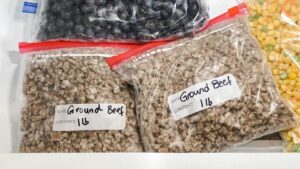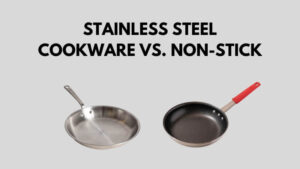The saucepan and saucepot are two common but often confused items in the kitchen. While they’re similar, their sizes, shapes, uses, etc., set them apart. If you’re shopping and not sure whether you need them both or just trying to understand which to use for your recipe, it helps to know the key saucepan vs saucepot differences. Let’s get into the details!
Saucepan vs saucepot: What are the differences?
Since both have “sauce” in their name and pots and pans tend to be used interchangeably, it is easy to mistake the two. But saucepans and saucepots actually differ in many ways. If you have ever wondered what is the difference between a saucepan and a pot, this breakdown is here to make things clear.
| Saucepan | Saucepot | |
|---|---|---|
| Material | Variety of materials; some have non-stick interiors; lightweight | Variety of materials; heavy |
| Appearance | Straight, steep sides with one long handle and a lid | High walls, two loop handles, and a lid |
| Usability | Liquid-based recipes; quick-cooking | Liquid-based recipes; slow-cooking |
| Size | Smaller, ranging from 1–4 quarts | Larger, ranging from 2–12+ quarts |

Material
Saucepans and saucepots are both made of a variety of materials, such as cast iron, copper, stainless steel, and aluminum. Some saucepans have non-stick interiors, but this is often not the case with saucepots. Considering the typical saucepan vs saucepot materials, the latter is also heavier.
Read more: Granite Cookware vs Ceramic Cookware: Which is Better?
Appearance
A saucepan is small and has straight, steep sides along with one long handle. It is fairly easy to pick up and move on and off the stove. A lot of the time, it comes with a fitted lid. Similarly, a saucepot has high walls and a lid. However, it is bigger and has two loop handles on either side. In general, a saucepot is bulkier than a saucepan.
Usability
Both saucepans and saucepots are used for cooking liquid-based recipes. They can simmer, stew, and boil. But saucepots are better when you need to cook over a long period of time. In contrast, between sauce pots vs sauce pans, the latter is best for whipping something up on the whim. If you frequently find yourself reheating leftovers, you will also be glad to know that saucepans are fantastic for the job.
Size
Saucepans range from 1 to 4 quarts, while saucepots are between 2 and 4 quarts. If you are cooking for many people or cooking with ingredients that require more space, saucepots are the better choice. If you are handling small and medium portions, saucepans will do.
Sauce pot vs sauce pan: People and purposes
Whether a saucepan vs saucepot is better is based on who you’re cooking for and what you typically make. Here is how they stack up:
| Saucepan | Saucepot | |
|---|---|---|
| For up to 2 people | ✓ | |
| For 3 or more people | ✓ | |
| For making sauces | ✓ | |
| For boiling water | ✓ | |
| For stews, stocks, and soups | ✓ |
People
Because a saucepot is bigger, it is more suitable for large families. If you cook for yourself or just one other person, a saucepan can get the job done. For example, if it is you in a dorm or you and your partner in an apartment, you don’t need a saucepot because it is more difficult to handle and takes up more space.
However, a saucepot can come in handy during special occasions, such as Thanksgiving, as the table can be packed with people and dishes are rather elaborate. Do you frequently have friends coming over? Does your extended family gather often? If you answered yes to either, having a saucepot ready is a good idea.

Purposes
Saucepans, as you can probably guess, are best for making sauces. Thanks to their straight, steep sides, you can easily simmer, stir, and manage a typical batch of sauce without having to worry about it splattering or losing heat.
Saucepans are also great for boiling. Their sides minimize evaporation and the handle offers easy control when pouring. You can use a saucepan to boil water for pasta, noodles, grains, vegetables, etc. Poaching eggs for a protein-packed breakfast is also an option.
Saucepots are great for making stews, stocks, and soups. Like saucepans, they heat evenly, which helps create the rich flavors that define these recipes. Saucepots’ wider bases make it possible to hold large ingredients and brown them, sprucing flavor even further. Since stews, stocks, and soups usually take more time on the stove, saucepots fit the bill, too.

Saucepan vs saucepot: Do I need both?
This is a dilemma many face. But, unfortunately, the answer is not a clear-cut yes or no. How often you cook and what you like to make can play a role.
If your meals are mostly small and simple, you can go with just a saucepan. However, if you regularly cook for many people or slow-cooked stews, stocks, and soups are a staple in your diet, a saucepot is definitely worth the investment.
While it is possible to get by with just one of the two sauce pot vs sauce pan, having both in your kitchen gives you flexibility. For instance, if you have to host a party or your little ones suddenly crave soup like Grandma’s, you can still make it happen!
It is also important to consider your kitchen space and budget. If you’re really tight on both, a saucepan can still work wonders. It is versatile enough to handle most of your cooking tasks effectively. You don’t have to push yourself to get a saucepot.

Conclusion
Now that you understand the main saucepan vs saucepot differences, you can decide which your kitchen or recipe calls for. Both can handle liquid-based dishes, but a saucepan is more suitable for solo, small, and simple cooking.
In contrast, a saucepot is better for bulk cooking and slow cooking. It is bigger, heavier, and ideal for stews, stocks, and soups, enjoyed by many people at once.
Each has its advantages and having both will make your life easier. However, if that is not an option, you should think about who you’re cooking for, what, how, and where you’re cooking, as well as your budget to determine whether a sauce pot vs sauce pan is better for you.








